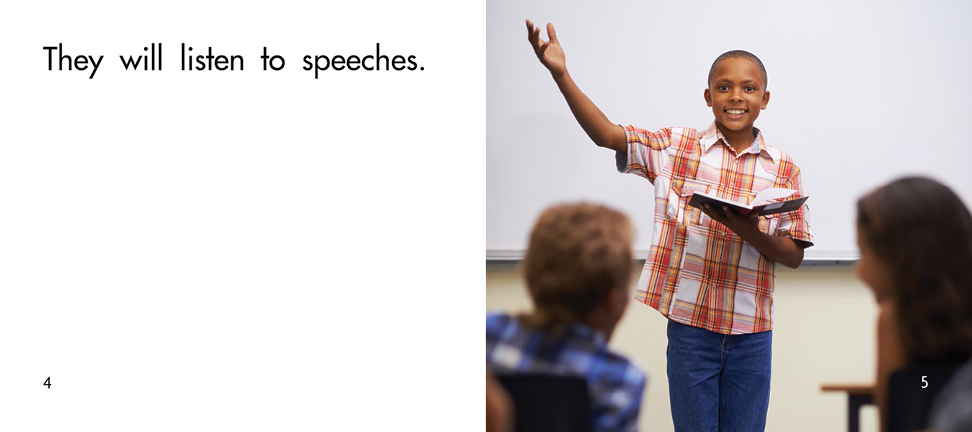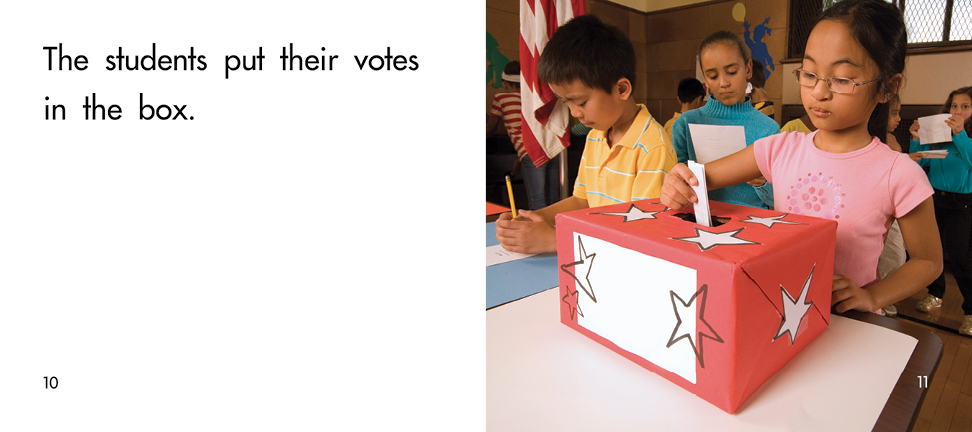
Genre: Informational Text
Text Level: C/4
Lexile®: 300L
Word Count: 60
Additional Materials
- Level C Prompting Card
- Self-stick notes
Summary
Students get to vote for a leader. They listen to speeches and read posters. After they vote, the votes are counted and a new student leader is chosen.
Learning Goals
- Determine text importance.
- Draw inferences.
- Apply Level C reading behaviors.
Responsive Teaching: Small-Group Reading
Based on your observational notes and progress-monitoring oral reading records, identify specific behaviors you want to support with each student. Use the language on the Level C Prompting Card to scaffold their development.
Focus (2 min.)
Engage
Briefly introduce the book to help students engage with meaning and activate strategies. Allow students to preview the book on their own.
- What did you notice as you previewed the book? Where does this text take place? What questions do you have about the main topic of the book?
Identify Genre
- Based on your preview, do you think this book is fiction or nonfiction? What clues makes you think that?
Build Social and Emotional Mindfulness
- In this book, you’re going to read about students choosing a new leader by voting. As you are reading, think about how voting is related to making decisions.
Vocabulary Support for English Learners
- Discuss the words vote and choice. Point out that a choice is what people decide they want, or choose. People vote by marking a paper or raising hands to show the choice. The one with the most votes wins.
- Use the photographs to pre-teach words such as speeches and posters. Ask students to identify unknown words in the text. Help them decode them using context clues, letter patterns, syllabication, and word parts.
Debbie Whitt Jarzombek
A book introduction scaffolds readers and sets them up to successfully read a text within their instructional reading level band.
Model (3 min.)
Comprehension Strategy
You may wish to model the same strategy or skill you taught during the day’s reading mini-lesson (or a previous mini-lesson), based on the needs of your readers. If available, use an existing anchor chart to support your modeling.
The following are some suggested strategies for this book:
- Determine Text Importance
- Identify Central Idea (Main Topic) Including the Supporting Evidence
- Identify Genre: Informational Text
- Use Text to Determine Word Meanings
Sample Modeling:
Determine Text Importance
- When I think back about the information in this book, I think about what information was interesting and what information is important to remember. I think that listening to speeches and reading posters was interesting information.
- I think the information on voting on pages 8, 10, and 12 is important. To remember, I will put self-stick notes by the information I think is important.
Guide Practice (5–6 min.)
Read
Have students read the text independently in a quiet voice, self-monitoring for meaning as you move around the table and coach as needed.
* Use the Level C Prompting Card as a reference to maintain precise, intentional interactions with students as they read.
Scaffold Reading Behaviors
Validate
Based on your observations during reading, quickly validate a reading behavior you saw students use. (See the Validate prompts on the Prompting Card.) Allow students to share how they used the strategy.
Demonstrate
Focus on a level-appropriate reading behavior you did not observe students use (see the Behaviors to Look For on the Prompting Card) and provide quick modeling of the behavior.
* Please note that Prompting Cards do not accompany all purchase options available for this title.

Level C Prompting Card
Linda Hoyt
When the reader stops reading and appeals to the teacher for help, the coach might say: “Read on.” ‘What strategies are you thinking you might use?” “What can you do to help yourself.”
Share, Reflect, and Transfer (3–5 min.)
Turn, Talk, and Listen
Have students turn to a shoulder partner and discuss the questions they had when previewing the text. Which questions were answered? Which were not?
Prompt students to draw inferences using the photographs to determine where the text takes place. Have them cite specific page numbers so that all students can note the evidence.
Build Social and Emotional Mindfulness
Help students build responsible decision-making. Have them discuss how the students voted for a new leader with and compare that how their class votes for either a new leader or new ideas.
Apply and Transfer
Work with students to apply the reading strategy or reading behavior you modeled. Encourage them to practice transferring this strategy and/or behavior to their independent reading.
Oral Language Support for English Learners
- You may want to do a think-aloud with students to remind them how to draw inferences and identify the setting.
- Provide key words as anchors to support discussing the setting of the text (examples: classroom, school, stage, auditorium). You may also provide sentence frames, such as: The students are in a ___. The text is about students who ___.
Sample Key Ideas and Draw Inferences
-
The whiteboard and other students make this look like the book is set in a school. I wonder why the boy is making a speech? (pages 4–5)

-
This picture also looks like children in a school. I see a boy voting in secret and a girl putting her vote in a box. (pages 10–11)

- The teacher and stage show me this book is about students voting in a school. The girl got the most votes so she is the winner. (page 16)
Build Fluency and Comprehension (5–10 min.)
Fluency
Model a fluency skill to support students’ reading. Choose a skill based on your observations and opportunities in the text.
Word Work
Choose an appropriate teaching point based on the needs of your students and the opportunities in the text.
Sample Teaching Point:
Prosody Expression
- Model reading page 2, showing how to read with expression. Point out the exclamation mark in the last sentence and show how you read that sentence with excitement.
- Have students practice reading the same page showing excitement at the exclamation mark. Then have them read the posters on page 7 with expression to their partner.
Sample Teaching Point:
High-Frequency Words
- Support students in reading high-frequency words. Write the words they and their on the whiteboard. Read each word and have students repeat.
- Find and point to the word they on page 4. Read it. Point to and read they on page 6. Find and point to the word their on page 8. Read it. Point to and read their on page 10.
Process Meaning Through Writing (5–10 min.)
Tell Steps in a Process
Utilize a shared writing approach for this part of the lesson.
Lead students in a discussion of why they think voting is a way to express their choice for a new leader. As students state opinions, agree upon sentences that you can write on chart paper.
Have students write a sentence that tells why voting is a way to express their individual choice. Each student verbalize his or her sentence before writing it.
Writing Support for English Learners
- Before they discuss and contribute to the steps, you may wish to have partners act out the process of voting. Allow them to use the text and photographs for each step. Provide sentence frames for writing such as: When people vote, they can ___.
Adria Klein
It has been well proven that writing influences content retention and acquisition of academic vocabulary, and enhances reasoning ability.
Progress Monitoring
You might plan to have one or two students stay behind from the group for a progress-monitoring oral reading record. This book has 60 words. Have students read the entire book. Record your observations on the Oral Reading Record Form and use the Oral Reading Record Analysis form for Levels A/1–E/8.